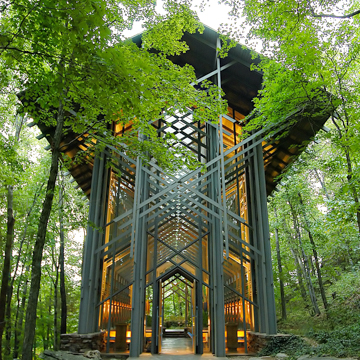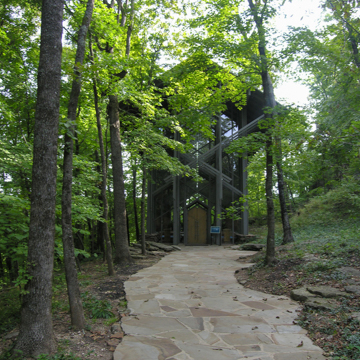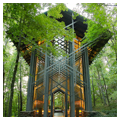Perhaps the best-known building designed by Jones is Thorncrown Chapel. The chapel stands on a narrow shelf of a wooded north slope of the Ozark Mountains, about a mile west of the Eureka Springs’s city limits. Thorncrown Chapel was the architect’s response to a request by landowner Jim Reed, who donated the land on which it stands, to create a chapel that would encourage worship by passers-by. The chapel’s verticality echoes the surrounding trees, and the stone of the base, harvested from the hillside, helps the chapel become a part of its natural site. The almost ethereal side walls are tall sheets of glass separated by sturdy wooden columns rising from low stone walls. The architect’s construction plan called for trusses of assembled two-by-fours no heavier than could be transported by a two-person team. The transparent pattern of the sixty-eight-foot rectangle was repeated twenty-two times, until all were in their permanent structural positions. The basic truss is centered by steel, architect-designed, diamond-shaped connectors. Pairs of steel arms extend from each diamond, each pair of arms embracing two-by-four wood rafters by selected nails. The single rafters at the glass wall receive additional strength and extend to the edge of the roof. The orderly complexity of this truss assembly and the roof overhang emulates the crossed, leafy branches of the trees outside, mixing shade with daylight provided by the skylight straddling the roof ridgeline. The precise alignment of the open diamonds provides an almost mystical stability to the interior and creates an axis countered by a slightly off-center cross beyond the glass of the chancel window. A central aisle, six feet wide, separates two banks of pews. The only note of color in the chapel is that of royal blue pew-length cushions. Carpenter-built light fixtures, architect-designed, are mounted on the sturdy wood columns between the large glass windows forming both walls of the chapel. As dusk arrives the windows become mirrors, reflecting the interior of the opposite side of the chapel and the illuminated cross-shaped light fixtures column-mounted on the opposite wall. An unexpected and almost mystical result of these reflections is a multi-reflection of the cross-like images moving in endless procession, diminishing in size as the luminous small bright crosses recede into the darkness of the natural woods enveloping the chapel. The American Institute of Architects (AIA) has included the chapel on its list of the ten greatest buildings of the twentieth century in the United States.
In order to preserve the serene atmosphere of Thorncrown Chapel, Jones and Maurice Jennings were commissioned to design a three-hundred-seat Worship Center to accommodate demands for public functions. The building (1989) set on a steeply sloping site near Thorncrown is twice as wide as the chapel, has solid wooden walls, a steeple, and, inside, a wooden truss-supported roof and clerestory windows. But the tripartite window at the end of the nave, which gives views to the landscape beyond, emphasizes the bond between what is constructed and what exists in nature, a characteristic of many of Jones’s buildings.





